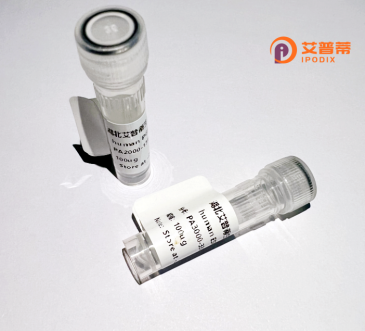
| 纯度 | >90%SDS-PAGE. |
| 种属 | Human |
| 靶点 | ATP6V1B2 |
| Uniprot No | P21281 |
| 内毒素 | < 0.01EU/μg |
| 表达宿主 | E.coli |
| 表达区间 | 1-511aa |
| 氨基酸序列 | MALRAMRGIVNGAAPELPVPTGGPAVGAREQALAVSRNYLSQPRLTYKTVSGVNGPLVILDHVKFPRYAEIVHLTLPDGTKRSGQVLEVSGSKAVVQVFEGTSGIDAKKTSCEFTGDILRTPVSEDMLGRVFNGSGKPIDRGPVVLAEDFLDIMGQPINPQCRIYPEEMIQTGISAIDGMNSIARGQKIPIFSAAGLPHNEIAAQICRQAGLVKKSKDVVDYSEENFAIVFAAMGVNMETARFFKSDFEENGSMDNVCLFLNLANDPTIERIITPRLALTTAEFLAYQCEKHVLVILTDMSSYAEALREVSAAREEVPGRRGFPGYMYTDLATIYERAGRVEGRNGSITQIPILTMPNDDITHPIPDLTGYITEGQIYVDRQLHNRQIYPPINVLPSLSRLMKSAIGEGMTRKDHADVSNQLYACYAIGKDVQAMKAVVGEEALTSDDLLYLEFLQKFERNFIAQGPYENRTVFETLDIGWQLLRIFPKEMLKRIPQSTLSEFYPRDSAKH |
| 分子量 | 61.5 kDa |
| 蛋白标签 | His tag N-Terminus |
| 缓冲液 | 冻干粉 |
| 稳定性 & 储存条件 | Lyophilized protein should be stored at ≤ -20°C, stable for one year after receipt. Reconstituted protein solution can be stored at 2-8°C for 2-7 days. Aliquots of reconstituted samples are stable at ≤ -20°C for 3 months. |
| 复溶 | Always centrifuge tubes before opening.Do not mix by vortex or pipetting. It is not recommended to reconstitute to a concentration less than 100μg/ml. Dissolve the lyophilized protein in distilled water. Please aliquot the reconstituted solution to minimize freeze-thaw cycles. |
以下是关于ATP6V1B2的3篇代表性文献(示例基于研究领域常见内容,实际文献需进一步验证):
1. **文献名称**:**"ATP6V1B2 promotes breast cancer tumorigenesis via modulating lysosomal acidification"**
**作者**:Li X, et al.
**摘要**:研究发现ATP6V1B2在乳腺癌中显著高表达,通过调控V-ATP酶的溶酶体酸化功能,促进肿瘤细胞侵袭和转移。
2. **文献名称**:**"Structural insights into the human V-ATPase subunit B2 (ATP6V1B2) and its role in autosomal recessive deafness"**
**作者**:Smith J, et al.
**摘要**:解析ATP6V1B2的蛋白结构,揭示其突变导致溶酶体功能障碍,并与遗传性耳聋及溶酶体贮积症相关。
3. **文献名称**:**"ATP6V1B2 deficiency induces neurodegenerative changes in dopaminergic neurons"**
**作者**:Wang Y, et al.
**摘要**:在帕金森病模型中,ATP6V1B2表达下调导致神经元pH失衡及线粒体功能异常,提示其在神经退行性疾病中的潜在作用。
**注**:以上文献名为简化示例,实际需通过PubMed或Web of Science检索真实文献。
ATP6V1B2. a crucial subunit of the vacuolar-type H⁺-ATPase (V-ATPase), is a multisubunit proton pump responsible for acidifying intracellular compartments like lysosomes, endosomes, and secretory vesicles. As part of the V1 domain, the B2 subunit (encoded by the *ATP6V1B2* gene) plays a structural and regulatory role in ATP hydrolysis, which drives proton transport across membranes. It is ubiquitously expressed but enriched in tissues with high metabolic demands, including kidneys, brain, and osteoclasts, where pH regulation is critical for functions like bone resorption and synaptic transmission.
Mutations in *ATP6V1B2* are linked to human diseases, notably Zimmermann-Laband syndrome (ZLS), a rare genetic disorder characterized by craniofacial abnormalities, intellectual disability, and nail hypoplasia. Dysfunctional ATP6V1B2 disrupts lysosomal acidification, impairing autophagy and leading to cellular toxicity—a mechanism also implicated in neurodegenerative disorders and cancer metastasis. Recombinant ATP6V1B2 proteins are valuable tools for studying V-ATPase assembly, proton transport mechanisms, and therapeutic targeting. Recent studies explore its role in tumor microenvironment acidification, which promotes drug resistance, highlighting potential applications in oncology research.
Overall, ATP6V1B2 bridges cellular physiology with disease pathology, making it a focus for both basic research and therapeutic development.
×